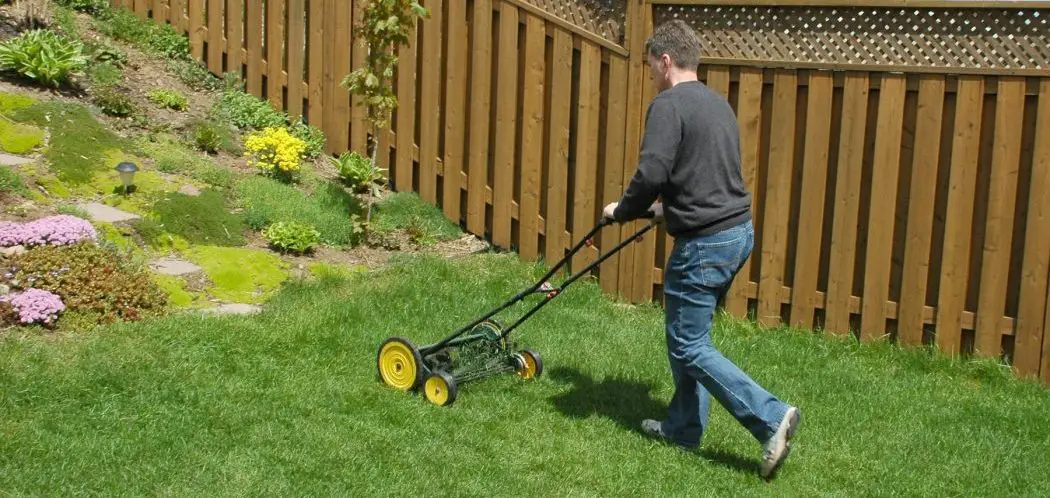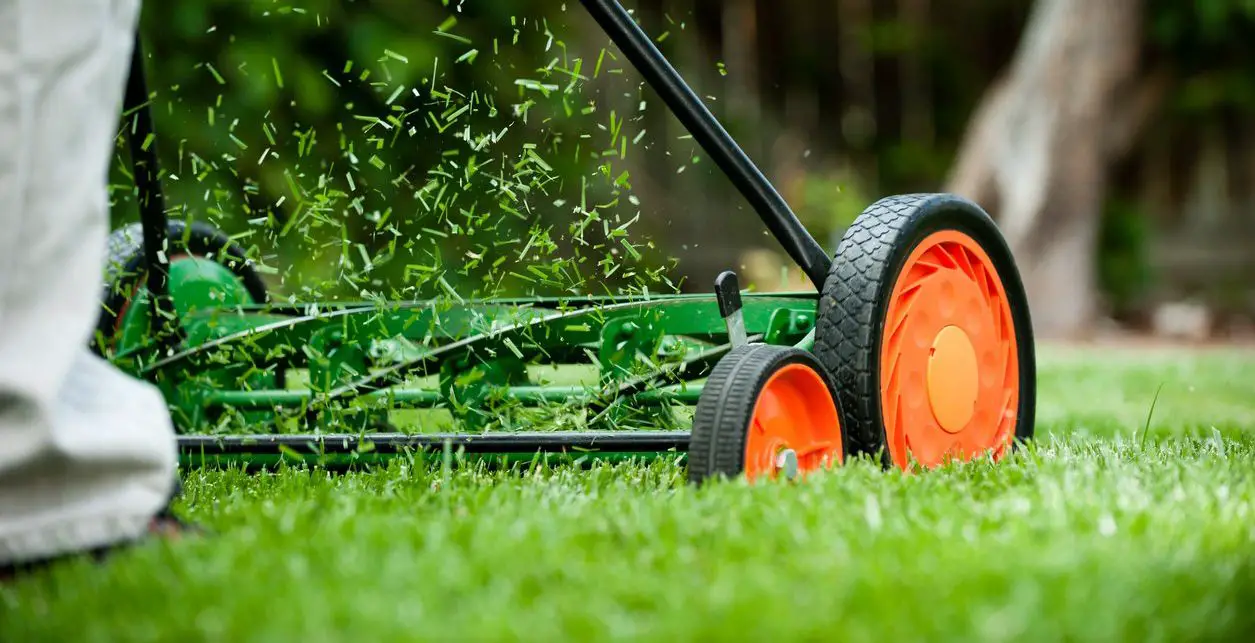When raindrops tap against the windowpane, most homeowners rejoice at the prospect of a lush, green lawn ahead. But for those using traditional reel mowers, rain brings an element of apprehension.
Will the lightweight reel mower slide out of control on rain-soaked turf? Or should you shelve mowing until the turf fully dries?
While dry conditions are ideal, reel mowers can in fact cut damp grass reasonably well. But special precautions and adjustments are required compared to mowing dry turf.
Reel mowers can cut wet grass, but it’s not ideal. Cutting wet grass can lead to an uneven and ragged cut. Additionally, the moisture can cause the grass clippings to stick and clog between the blades, making it more challenging for the mower to function efficiently. It’s best to mow when the grass is dry for optimal results.
In this detailed guide, we will cover:
- The inherent challenges reel mowers face when cutting wet grass
- Practical techniques to maintain safety and efficiency in slick conditions
- Adjustments to mower settings and blade care for successful wet mowing
- Proper cleaning and maintenance after exposing the mower to moisture
- Specific scenarios where waiting for drier conditions is recommended
While at first glance the idea of pushing a reel mower through slick, soaked turf may seem daunting, a little adaptation and care lets you keep the lawn neatly trimmed even after substantial rains.
Let’s first look at why perfectly dry grass makes the job easier, while wet conditions introduce new risks and difficulties.
Challenges of Mowing Wet Grass with Reel Mowers
Most reel mower owners rightly prefer dry turf conditions when taking to the lawn. Here’s why dampness poses hurdles:
Diminished Tire Traction
The primary difficulty wet grass introduces is significantly reduced wheel traction and control due to the slick moisture sitting on grass blades. This lack of grip makes it harder to maintain straight mowing lines or crisp turns. Reel mowers require more focused guidance when cutting wet turf.
Increased Sliding Risk
In addition to diminished tire grip, the overall lightweight design of reel mowers compounds the traction issue. Without substantial weight pressing the tires down into the turf, the mower is prone to sliding sideways down slopes when attempting to cut wet grass. Caution is required.
Less Precise Cut Quality
Another consequence of wet conditions is that grass blades tend to bend and lay over when moist rather than standing upright and proud. This poses a challenge for reel blades designed to make precision slices through erect leaf blades. Expect cutting quality to suffer slightly when grass remains damp.
Promotes Rust Formation
Leaving a reel mower coated in moist grass clippings after mowing promotes rust and corrosion formation as moisture sits on steel components. Proper post-mowing cleaning is crucial after cutting wet turf.
Debris Buildup
Another issue many notice is wet grass clippings seem to stick and cling to reel mower parts rather than dispersing evenly over the lawn as they would in dry conditions. Wet clumps accumulating on moving parts can inhibit smooth function.
No question, perfectly dry turf is ideal for reel mower operation. But with prudent adjustments and care, cutting damp grass remains feasible. Next we’ll explore tips to maintain control and efficiency.
How Do Reel Mowers Compare to Other Mower Types for Wet Grass?
Reel cylinder mowers face distinct wet turf challenges different from rotary, hover, and robot mowers.
Here’s how they compare:
- Rotary Mowers: Gas-powered rotary mowers provide much greater traction and stability to power through dampness without sliding thanks to heavier weight. But they lack the precision cutting of reels.
- Hover Mowers: Floating hovering cutters glide safely over slick surfaces but can scalp wet grass laid down flat. Limited traction climbing slopes.
- Robot Mowers: Robotic mowers distribute weight widely for decent wet traction. But onboard sensors may struggle with very tall saturated grass.
While other mower varieties have design advantages that reduce wet mowing headaches, a properly operated reel mower is still quite effective at slicing neat, clean cuts even when the lawn is still soaking wet.
Adjusting Your Reel Mowing Technique for Safely Mowing Wet Grass
When confronted with slick, soaked turf, tailor your reel mowing technique to limit issues:
Move Slowly and Cautiously
The number one rule when mowing damp grass is to take it slow and steady. Carefully roll the mower over the terrain rather than pushing rapidly and aggressively as you might in dry conditions. Accelerate gradually, and avoid quick stops or pivots. Gentle is key.
Maintain Stable Footing
Plant your feet widely at shoulder length rather than striding quickly. Keep knees slightly bent and torso centered over feet rather than hunched over the handles for optimal stability. Shuffling fast with narrow unstable footing risks slipping on wet grass.
Make Slow, Controlled Turns
Gingerly arc turns in a widely sweeping motion rather than pivoting sharply on wet turf. Gradual maneuvers are far less likely to break traction and send the mower sliding. Avoid abrupt direction changes.
Follow Existing Tire Tracks
Once initial mowing passes imprint visible tire tracks in the turf, carefully follow in those same tracks to repeat subsequent overlaps. Trampled grass has slightly improved grip. Re-rolling the same path helps avoid slides.
Widen Reel Cutting Width
If your mower allows width adjustments, open the cutting reel to its widest effective setting. This extends the mower’s stability footprint to limit potential side-to-side slipping. But don’t over-widen on steep hills.
Raise Mower Cut Height
Adjusting to a taller cutting height eases ground pressure between tires and turf, allowing slightly better traction, especially when crossing spongy areas. Only raise height incrementally as needed to maintain momentum.
Keep Blades Freshly Sharpened
A freshly honed reel blade cuts through damp grass more cleanly and easily versus trying to saw through wetness with a dull, blunted blade. Precision slicing prevents the grass from matting down under the mower.
With astute operation, damp grass mowing can still achieve quality results using a reel mower. But special precautions must be taken on slopes.
Extra Wet Reel Mowing Precautions on Sloped Lawns
Sloped areas always require maximum attention when mowing, but the risks multiply significantly when attempting damp grass on hills or inclines. Several precautions can mitigate hazards:
Avoid Steep Slopes When Very Wet
Use good judgment in assessing whether turf is still too wet to traverse steep slopes safely. Consider mowing flatter areas first, saving dangerously slick sloped sections for drier conditions that allow secure footing.
Keep Front of Mower Lightly Raised
When mowing down steeper slopes, cautiously lift the mower’s front end slightly to gently “wheelie” and shift weight rearward. This avoids uncontrolled sliding from gravity. But don’t lift so far you tip backwards!
Go Across, Not Down, When Possible
Descending straight downhill on a soaked slope greatly amplifies slip risk. For milder side-to-side pitches, traverse laterally across the incline rather than directly downhill. Less danger of losing control.
Add Optional Rear Weights
Some reel mowers allow attaching weights over the rear wheels to provide extra downward force and grip when sodden conditions demand it. But don’t overload weight on steep grades.
Use Cordless Drill Drive Assist
Securing a cordless drill to the side reel drive with a transfer bit eases slope mowing by letting the drill motor take over spinning the blades. This leaves both hands free to fully focus on safe navigation.
Even modest inclines and side hills become exponentially more hazardous when attempting to reel mow wet turf. Weigh the risks carefully before tackling precipitous slopes under slick conditions.
Next we’ll look at proper aftercare following wet mowing to avoid any long-term equipment damage.
When to Avoid Reel Mowing Wet Lawns Altogether
Under certain lawn conditions, holding off on mowing until things dry out remains the safest policy even when using a reel mower.
Standing Water Remains
Large puddles and pools of standing water create perilous hidden slip risks. Allow time for complete water absorption and drainage before attempting to mow flooded areas.
Grass Remains Very Muddy
Even after precipitation stops, excessively muddy soil and grass can hinder both tires and cutting. Let the lawn dry adequately before mowing to avoid gooey mud clumps riding up into the reel.
Heavy Rainfall Creates Leaf Clumping
Sometimes heavy rains cause grass blades to flatten together into clumped mats as they dry. These won’t cut cleanly until separating and regaining structure when fully dry.
Storms With Lightning Remain Active
Steer clear of operating any electrical-powered equipment during active thunderstorms and lightning activity. Wait for storms to fully dissipate.
Key Takeaways for Reel Mowing Wet Grass
Here are the critical tips for safely and successfully taking a reel mower onto wet turf after rain or morning dew:
- Move with extreme care and gradual maneuvers. Maintain secure footing at all times.
- Keep reel blades sharpened routinely for clean cutting even through dampness.
- Make mower setting adjustments like raising height and widening width to compensate for reduced traction.
- Avoid mowing slopes during very slick conditions. Use cordless assist if needed.
- Aggressively dry metal components and lubricate key parts after exposure to moisture.
- Hold off on mowing standing water, muddy areas, or matted clumps of grass.
Remaining ever-vigilant of the footing and terrain transforms tricky wet mowing into a conquered chore. Take it slow and steady.
The Final Verdict
When rain clouds loom, don’t let doubtful anxiety about mowing damp turf with a reel mower spoil your plans. While extra care is required, cutting wet grass is certainly within reason.
Admittedly, bone-dry conditions are the ideal scenario for easy reel mower handling. But by proactively adapting technique, making prudent equipment adjustments, and properly caring for your mower post-mowing, soaked turf need not halt your lawn care regimen.
Approach wet mowing with sensible caution, respect the additional risks, and you can maintain a tidy, well-manicured lawn rain or shine. The modest compromise in cutting perfection is worth upholding summer lawn care routines even after downpours leave grass sopping wet.
Have you discovered any other helpful tips for successfully mowing wet turf with your trusty reel mower? We want to hear them, so please share your experiences and wisdom!





